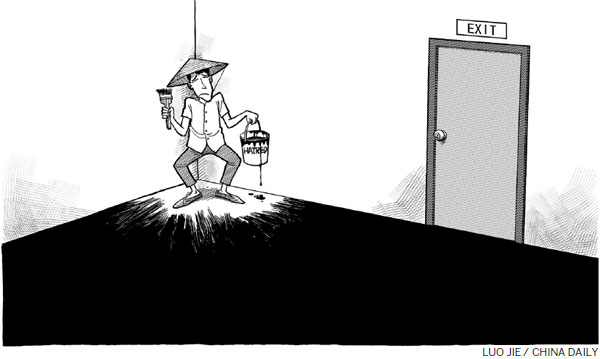Hanoi must stop muddying the waters
By Jin Yongming (China Daily) Updated: 2014-05-21 07:09Vietnamese vessels have repeatedly disrupted China's drilling activities in the South China Sea ever since Beijing placed its deep-sea oil rig, HD-981, in the waters south of Xisha Islands on May 2. And the deadly anti-China protests across Vietnam amid escalating tensions between Beijing and Hanoi have severely endangered the safety of Chinese nationals and damaged Chinese enterprises' property in Vietnam.
The main dispute between the two neighbors is whether or not China has the right to operate the rig located 17 nautical miles (31.5 kilometers) from Zhongjian Island of China's Xisha Islands and about 150 nautical miles from Vietnam's coast. As the Chinese Ministry of Foreign Affairs said, operations like the latest one - carried out within China's contiguous zone - started 10 years ago, and a seismic operation and well site survey were conducted in the waters even in May and June last year.
History shows that Chinese authorities have more than once named and mapped the islands in the South China Sea based on various surveys, especially those in 1935, 1947 and 1983. Based on the U-shaped line, which first appeared in an official map published by China in 1948, the then Chinese government claimed sovereignty and jurisdiction over the islands in the South China Sea. Later, the government of New China retained the previous names of the island groups while supplementing them with a list of geographical names in 1983.
In May 2009, the Chinese Permanent Mission to the United Nations submitted a note to the UN secretary-general, urging the Commission on the Limits of the Continental Shelf not to review either the Malaysia-Vietnam joint submission on the outer limits of the continental shelf beyond 200 nautical miles from the baselines or Vietnam's separate submission on the same issue. While doing so, China reaffirmed its indisputable sovereignty over the islands in the South China Sea and their adjacent waters, and its sovereign rights and jurisdiction over the relevant waters and seabed and subsoil thereof. In fact, this has been Beijing's consistent position for years.
True, according to the provisions for the continental shelf in the UN Convention on the Law of the Sea, Vietnam can claim an exclusive economic zone that extends 200 nautical miles from its baseline. But China issued a statement on May 15, 1996, announcing the geographical coordinates on the base points and straight baselines of the Xisha Islands. From these baselines, China can also measure the breadth of its exclusive economic zone and continental shelf.
Given their dispute over the overlapping exclusive economic zones in the South China Sea, Beijing and Hanoi are obliged to observe the UNCLOS provisions on the delimitation of the exclusive economic zone between states with opposite or adjacent coasts and settle their dispute equitably on the basis of international law.
UNCLOS provisions, however, do not specify how to delimit exclusive economic zones and continental shelves between states with opposite or adjacent coasts. Nevertheless, based on international practice, disputing parties usually resolve their overlapping claims with a median line drawn equidistant from their respective coastlines. Although such a median line between China and Vietnam does not exist, the oil rig Beijing has been operating is 17 nautical miles south of China's Zhongjian Island and about 150 nautical miles from Vietnam's coast - that is, a long way from the median line if it were to be drawn today.
The latest maritime standoff between China and Vietnam has dimmed the prospects of settling the South China Sea disputes through political means. China has for long been advocating that the disputes be resolved through political means, including bilateral dialogue and consultations. Accordingly, Beijing and Hanoi's agreements on the delimitation of the Beibu Bay and cooperation in fishing activities took effect in June 2004. And in March 2005, China, Vietnam and the Philippines signed the Tripartite Agreement for Joint Marine Seismic Undertaking in the Agreement Area in the South China Sea.
Apart from jeopardizing these agreements, the latest standoff has also undermined Beijing's and Hanoi's efforts to maintain stability and expand maritime cooperation in the South China Sea. For instance, China and Vietnam signed a six-point agreement in October 2011 on the basic principles guiding the settlement of maritime issues. In the same month, the two neighbors issued a joint statement reaffirming their political will and determination to settle maritime disputes through negotiations and friendly consultations and to safeguard peace and stability in the South China Sea.
In October 2013, the two sides signed another joint statement on further deepening their comprehensive strategic cooperative partnership in the new period, according to which they were supposed to accelerate cooperation in a wide range of fields, including marine research and protection of marine environment. They agreed not to make any move that could complicate or escalate the disputes and vowed to continue discussions and take efficient measures to prevent the disputes from escalating and to maintain peace and stability in the South China Sea. The latest standoff could compromise these goals.
Despite Vietnam's accusations and attempts to portray itself as a victim, China has the legitimate right to operate its oil rig in the waters near the Xisha Islands, and Hanoi is squarely to blame for the damage caused to Chinese property and operations in Vietnam. To maintain good bilateral relations and implement the measures stated in bilateral political agreements, however, Beijing has to clarify its position through different means and should try to minimize the impact of the standoff to better defend its national maritime rights and interests.
The author is the director of the Center for China Marine Strategy Studies, Shanghai Academy of Social Sciences.











